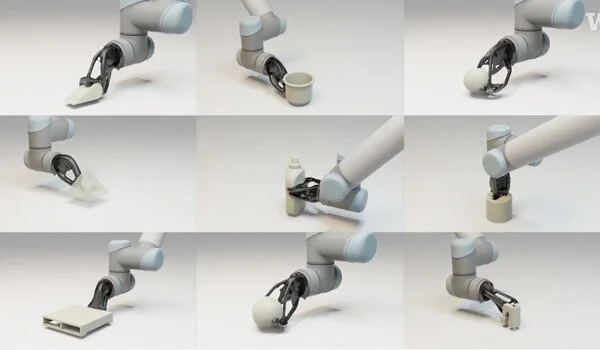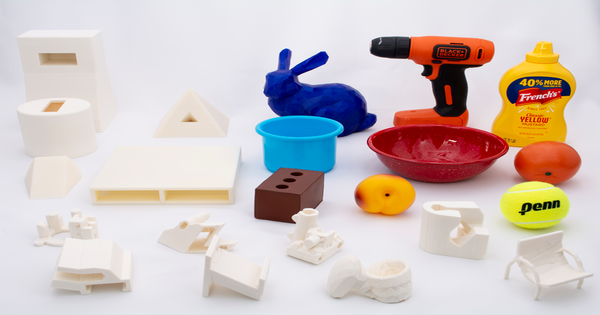A team from the University of Washington developed a new tool that can design a 3D-printable passive gripper and calculate the best path to pick up an object. The system was tested on a set of 22 objects, including a 3D-printed bunny, a doorstop-shaped wedge, a tennis ball, and a drill.
At the start of the COVID-19 pandemic, car manufacturers such as Ford quickly shifted their production focus from automobiles to masks and ventilators. These companies relied on people working on an assembly line to make this switch possible. It would have been too difficult for a robot to make this transition because robots are bound to their usual tasks.
In theory, if a robot’s grippers could be swapped out for each task, it could pick up almost anything. To save money, these grippers could be passive, which means they pick up objects without changing shape, similar to how forklift tongs work.
A team of researchers at the University of Washington developed a new tool that can design a 3D-printable passive gripper and calculate the best path to pick up an object. The system was tested on 22 different objects, including a 3D-printed bunny, a doorstop-shaped wedge, a tennis ball, and a drill. For 20 of the objects, the grippers and paths were successful. The wedge and a pyramid shape with a curved keyhole were two of these. Both shapes are challenging for multiple types of grippers to pick up.
The team will present these findings at SIGGRAPH 2022.
First, our algorithm generates possible grasp configurations and ranks them based on stability and other metrics. The best option is then chosen and co-optimized to determine whether an insert trajectory is possible. If it can’t find one, it moves on to the next grasp configuration on the list and tries the co-optimization process again.
Adriana Schulz
“We still manufacture the majority of our products on assembly lines, which are fantastic but also extremely rigid. The pandemic demonstrated the importance of having an easy way to repurpose these production lines” Adriana Schulz, a UW assistant professor in the Paul G. Allen School of Computer Science & Engineering, is the senior author. “Our plan is to design custom tooling for these production lines. As a result, we have a very simple robot that can only perform one task with a single gripper. When I change tasks, I simply replace the gripper.”
Because passive grippers cannot adjust to fit the object they are picking up, objects have traditionally been designed to match a specific gripper.
“The tongs on a forklift are the most successful passive gripper in the world. However, forklift tongs only work well with specific shapes, such as pallets, which means that anything you want to grip must be on a pallet “said co-author Jeffrey Lipton, an assistant professor of mechanical engineering at the University of Washington. “‘OK, we don’t want to predefine the geometry of the passive gripper,’ we say here. Instead, we want to design a gripper based on the geometry of any object.”
There are numerous gripper designs that could be used for any given object. Furthermore, the shape of the gripper is linked to the path taken by the robot arm to pick up the object. If designed incorrectly, a gripper could crash into the object en route to picking it up. To address this challenge, the researchers had a few key insights.

“The points where the gripper makes contact with the object are essential for maintaining the object’s stability in the grasp. We call this set of points the ‘grasp configuration,'” said lead author Milin Kodnongbua, who completed this research as a UW undergraduate student in the Allen School. “Also, the gripper must contact the object at those given points, and the gripper must be a single solid object connecting the contact points to the robot arm. We can search for an insert trajectory that satisfies these requirements.”
When designing a new gripper and trajectory, the team starts by providing the computer with a 3D model of the object and its orientation in space – how it would be presented on a conveyor belt, for example.
“First, our algorithm generates possible grasp configurations and ranks them based on stability and other metrics,” explained Kodnongbua. “The best option is then chosen and co-optimized to determine whether an insert trajectory is possible. If it can’t find one, it moves on to the next grasp configuration on the list and tries the co-optimization process again.”
Once a good match is found, the computer outputs two sets of instructions: one for a 3D printer to create the gripper and one with the trajectory for the robot arm once the gripper is printed and attached.
The team chose a variety of objects to test the power of the method, including some from a data set of objects that are the standard for testing a robot’s ability to do manipulation tasks.
“We also designed objects that would be challenging for traditional grasping robots, such as objects with very shallow angles or objects with internal grasping – where you have to pick them up with the insertion of a key,” said co-author Ian Good, a UW doctoral student in the mechanical engineering department.
The researchers performed 10 test pickups with 22 shapes. All ten pickups were successful for the 16 shapes. Two shapes did not have at least one successful pickup. These failures were caused by problems with the computer’s 3D models of the objects. For one, a bowl, the model described the sides as thinner than they were. The model did not have the correct orientation for the other object, which resembled a cup with an egg-shaped handle.
Even without human intervention, the algorithm developed the same gripping strategies for similarly shaped objects. The researchers hope that this will allow them to develop passive grippers that can pick up a class of objects rather than having to create a unique gripper for each object.
Passive grippers cannot be designed to pick up all objects, which is one limitation of this method. While objects with varying widths or protruding edges are easier to pick up, objects with uniformly smooth surfaces, such as a water bottle or a box, are difficult to grasp without any moving parts. Still, the researchers were encouraged to see the algorithm do so well, especially with some of the more difficult shapes, such as a column with a keyhole at the top.
















